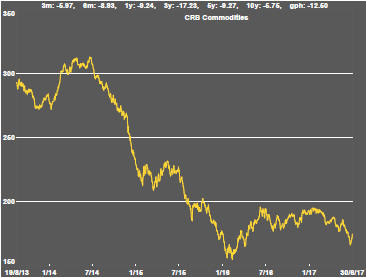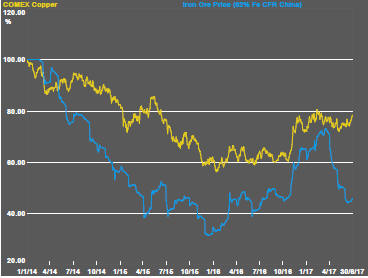The Current View
A lengthy downtrend in sector prices had given way to a relatively stable trajectory after mid 2013 similar to that experienced in the latter part of the 1990s and first few years of the 2000s.
The late 1990s and early 2000s was a period of macroeconomic upheaval during which time sector pricing nonetheless proved relatively stable.
Relative stability suggests a chance for companies genuinely adding value through development success to see their share prices move higher. This was the experience in the late 1990s and early 2000s.
Still vulnerable cyclical conditions were aggravated in the second half of 2015 by a push from investors worldwide to reduce risk. Sector prices were pushed to a new cyclical low. These conditions were largely reversed through the first half of 2016 although sector prices have done little more than revert to mid-2015 levels.
With a median decline in prices of ASX-listed resources companies through the cycle of 89%(and 30% of companies suffering a decline of more then 95%), the majority of stocks remain prone to strong 'bottom of the cycle' leverage in response to even slight improvements in conditions.
Has Anything Changed?
A 1990s scenario remains the closest historical parallel although the strength of the US dollar exchange rate since mid 2014 has added an unusual weight to US dollar prices.
The first signs of cyclical stabilisation in sector equity prices have started to show. This has meant some very strong ‘bottom of the cycle’ gains.
Funding for project development may have passed its most difficult phase at the end of 2015 with signs of deals being done and evidence that capital is available for suitably structured transactions.
Key Outcomes in the Past Week

Market Breadth Statistics


Signs that the era of cheap money might be drawing to a close began to show in financial markets. The German stock index has fallen by 3.2%.

German bond yields have pushed higher in the past week, close to their highest levels this year.

Crude oil related equities continued to track lower with movements in crude oil prices.

Within the S&P 500, technology sector stocks - the strongest performing S&P 500 component in 2017 - have appeared to lose momentum in the past two weeks. The momentum among energy sector stocks - the weakest performing S&P 500 component in 2017 - appeared to be improving perhaps indicating that investors are turning their minds to longer term relative value, albeit only at the margin.

Recent weakness in the U.S. dollar persisted taking the currency back to early 2015 levels (despite a move higher earlier in the week) but still leaving it in the upper part of its post-2014 trading range.
The currency outcomes appeared to reflect changing expectation about the trajectory of monetary policy. Interest rate rises in the US are now seen as leading rises in Europe to a lesser extent than had previously been expected although this judgement could change rapidly and frequently in the months ahead in response to the flow of growth and inflation data.
With growth and inflation in the USA and Europe moving within relatively narrow bounds, markets are likely to react to small movements contributing to volatility in financial markets as well as to sharp movements in commodity pricing.

The weaker dollar benefited commodity prices generally.

Non ferrous metal prices responded more strongly to the currency shift than iron ore prices.

The gold price remained in a tug of war between bond prices and the currency. The currency would have been a potential source of support but the beneficial impact was more than offset by the fall in bond prices leaving bullion prices modestly lower through the week.
.
The Steak or Sizzle? blog LINK contains additional commentary on the best performed stocks in the sector and the extent to which their investment outcomes are underpinned by a strong enough value proposition to sustain the gains.
